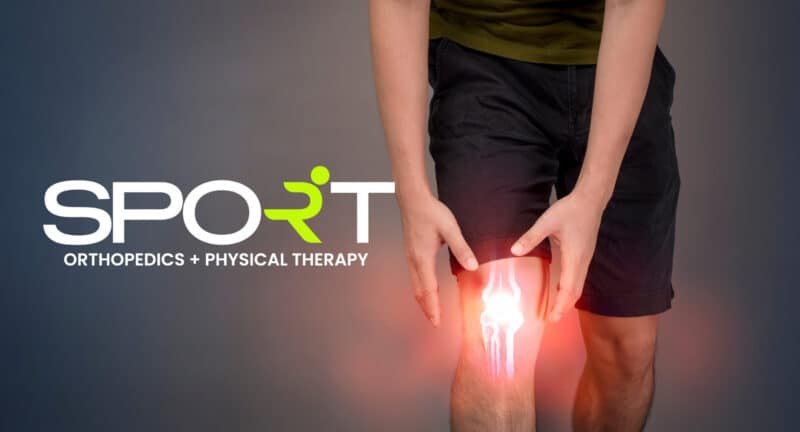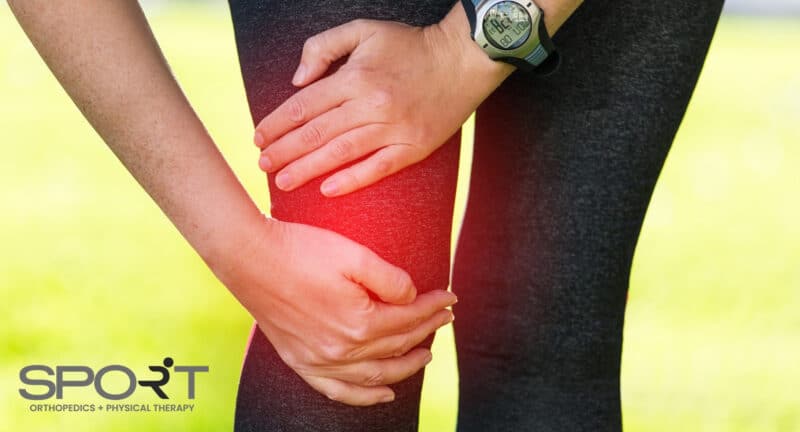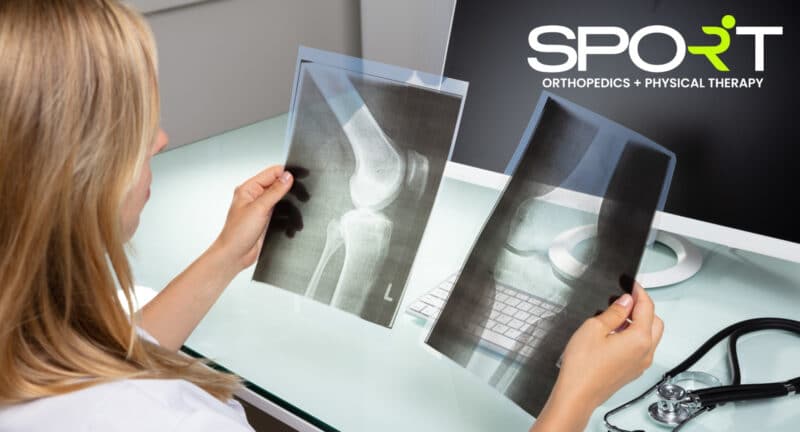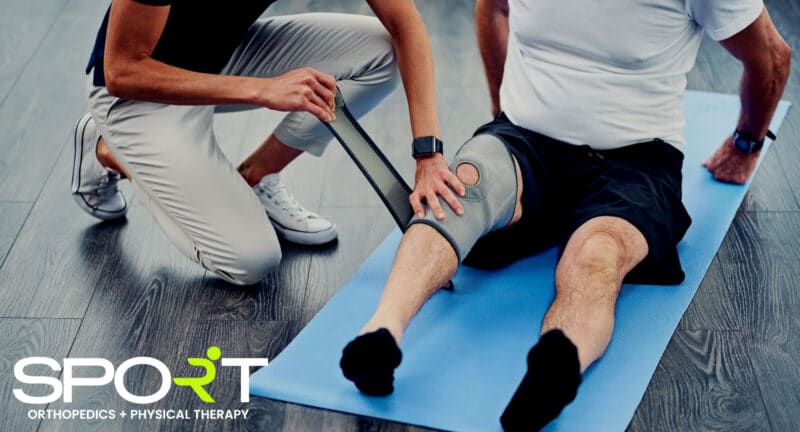MCL Tear Treatment in Dallas & Frisco
MCL Tears, Medial Collateral Ligament Tears
At SPORT, we understand your frustration after suffering an injury, particularly one as immobilizing as a knee injury. The medial collateral ligament (MCL) helps to stabilize the knee along with three other ligaments. These are the anterior cruciate ligament (ACL), the posterior cruciate ligament (PCL), and the lateral collateral ligament (LCL). When one of these ligaments suffers a tear, this can lead to knee instability, weakness, and pain. SPORT Orthopedics and Physical Therapy is here to quickly diagnose and treat your injury. That way, you can get back to the active lifestyle you enjoy. To schedule an appointment for your MCL tear, please call 469-200-2832 today.
What Is the Medial Collateral Ligament (MCL)?
The medial collateral ligament, as we stated before, is one of four crucial ligaments in the knee that provide stability. One end of this ligament attaches to the femur (thigh bone), while the other end attaches to the tibia (shin bone). It is located on the inner (medial) side of the knee joint. Its location partially explains why these MCL sprains and tears are so painful. If you have an injured knee, the best way to get a diagnosis is to visit a trusted orthopedic specialist in Dallas or Frisco. That way, you can know for sure what type of knee injury you have.
ACL vs MCL Injury
What is the difference between an ACL and MCL injury? While it can be difficult to tell on your own, there are telltale signs that the torn ligaments have. An anterior cruciate ligament injury will generally have a distinct popping sound, while most MCL tears do not. Even if you are fairly certain of which ligament was injured, you should still see a doctor to confirm the diagnosis.
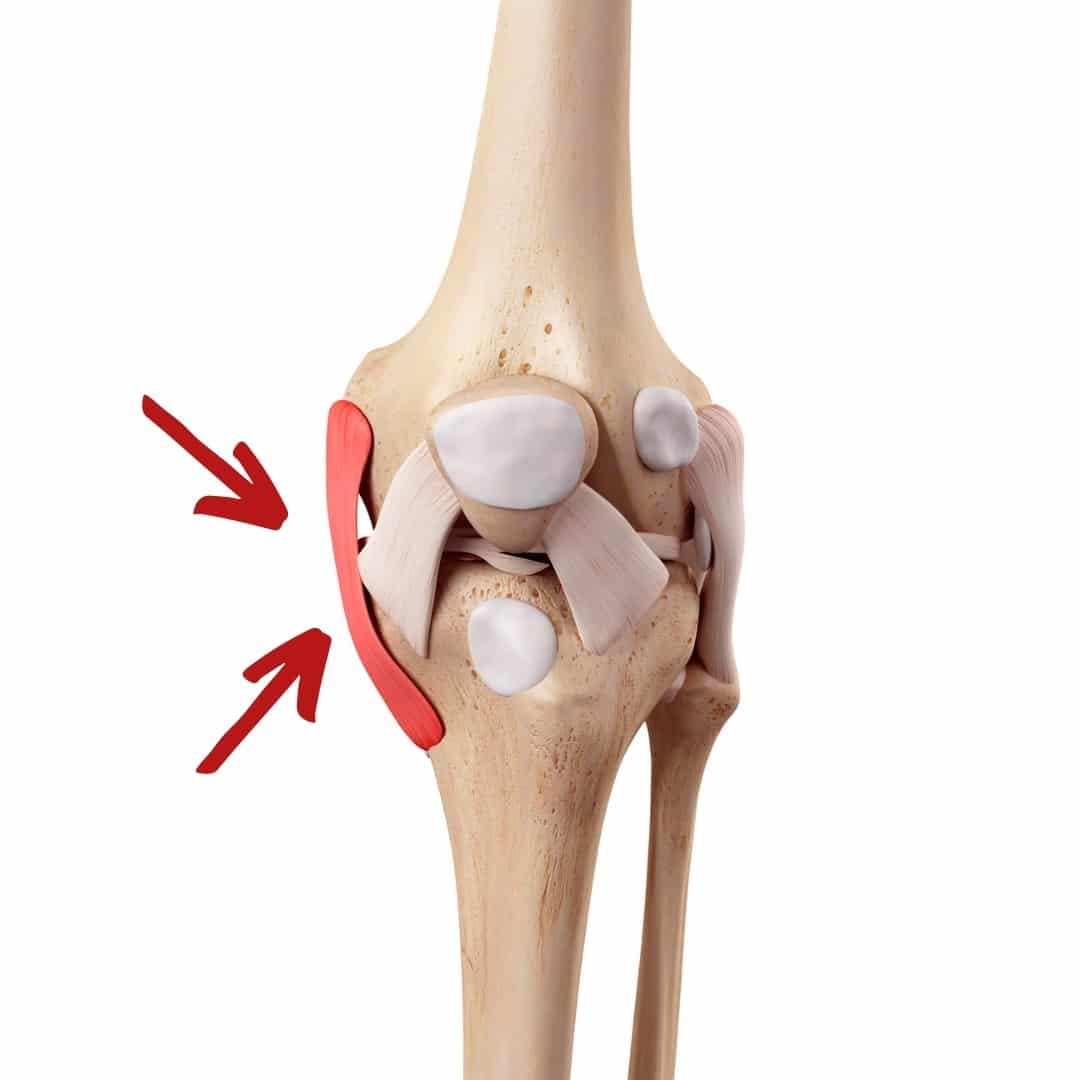
What Is an MCL Tear?
Medial collateral ligament tears involve damage to that specific ligament. These tears can be partial, meaning only some of the ligament fibers are torn, or complete. A complete tear is one in which the ligament is torn into two separate pieces. Because the ligaments serve to hold our joints, bones, and even organs in place, these ligament injuries can be serious.
Types of MCL Tears
Depending on the severity of your medial collateral ligament tear, your doctor will usually assign a “grade” to the tear during a physical examination. We outline the three grades of medial collateral ligament tears.
Grade 1
This is a mildly torn ligament. Generally, less than 10% of the fibers in the ligament are torn, and you still have most of your stability in the knee. A grade 1 tear is usually accompanied by tenderness, mild pain, and mild swelling.
Grade 2
This is a moderately torn ligament. It is more severe than grade 1 but less severe than grade 3. These injuries usually involve looseness in the knee that can be felt during a physical exam. The pain is intense, with added tenderness along the inside of the knee.
Grade 3
This is a severe, complete tear of the medial collateral ligament. The injured knee will be unstable and very loose. You will likely feel great pain, swelling, and tenderness with a severe tear. It is also common for patients with a complete MCL tear to experience other knee injuries alongside it. Examples include an LCL injury, ACL injury, or PCL injury.
What Does an MCL Tear Feel Like?
Knee injuries such as these often produce great pain for patients. Most individuals who suffer MCL tears will feel swelling and pain on the inside of the knee. While it is less common than with ACL injuries, you may hear a popping sound with a grade 3 tear. At the time the knee is injured, you may feel it give out to one side, as the MCL can no longer keep the knee stable.
It may be difficult to walk or apply pressure to the affected knee. Even with a partial tear, knee ligament injuries can make the knee feel loose, wobbly, or unstable. You may even feel a catching or locking sensation in the affected knee.
How Do I Know if I Tore My MCL or Meniscus?
Because there are so many soft tissues that help keep the knee joint stable, it can be difficult to pinpoint which one was injured. Luckily, the symptoms of ligament injuries vary just enough that a doctor will be able to confirm the source of your pain. A medial meniscal tear involves pain at the joint line, while MCL tears involve pain above the joint line. If you have difficulty identifying the source of your pain, speak with your orthopedist. They can more easily determine whether you have an MCL injury, meniscal injury, LCL injury, or other knee injuries.
What Causes MCL Injuries?
Most medial collateral ligament injuries occur as a result of sudden twisting or turning of the knee, as well as a direct blow to the outer side of the knee. These inner knee injuries are more common in those who play certain sports. Sports that have a higher risk of causing knee problems include soccer, football, basketball, volleyball, and even skiing. Below, we outline some examples of what can cause MCL injuries.
- Cutting to one side or direction when you play sports
- Direct blows to the outer side of the knee
- Lifting objects that are too heavy or squatting frequently
- Jumping and then landing awkwardly on your knee
- Hyperextended knee
- Repeatedly putting pressure or stress on the knee. This can lead to significant laxity in the four primary ligaments, much like a worn-out rubber band.
MCL Injury Symptoms
Symptoms of collateral ligament injuries usually vary depending on their severity. Specifically, an MCL sprain may have less serious symptoms when compared to a tear. The following are the most common symptoms of torn collateral ligaments.
- Hearing a popping noise when the injury occurs
- Feeling a catching or locking sensation in the affected knee
- Feeling like your knee might give out
- Having significant knee pain, tenderness, and stiffness
- Having swelling in the affected knee
MCL Tear Risk Factors
There are two main risk factors for an MCL injury. It is more common for the following age groups to suffer a medial collateral ligament injury.
- 20-34
- 55-65
Additionally, those who play contact sports increase their risk of an MCL injury. Examples of contact sports include football, basketball, rugby, hockey, and lacrosse.
MCL Tear Diagnosis
It is usually possible for orthopaedic surgeons to diagnose MCL tears through a physical examination. This exam involves bending the knee and applying pressure to it. To confirm the diagnosis, your doctor will likely order imaging tests, such as the following.
- Magnetic resonance imaging (MRI)
- Ultrasound imaging
- X-rays
How to Treat an MCL Tear
There are many treatment options available for those who suffer knee joint injuries. Your doctor will usually opt for conservative treatment before they turn to surgical repair. At SPORT, your doctor will work closely with a skilled physical therapist to develop a personalized treatment plan for you. Below, we outline the surgical and nonsurgical treatment options for an MCL tear.
Nonsurgical Treatments for MCL Tear
Initial treatment focuses on immobilizing the affected knee and managing both pain and inflammation of the area. The following are the techniques we recommend.
- RICE (rest, ice, compression, elevation)
- Pain medicine for managing immediate pain
- Wearing a hinged knee brace that restricts horizontal flexion
Depending on the severity of your injury, you may not be allowed to wear a hinged brace. In this case, you will wear a knee brace that does not allow you to bend your knee. It is important to change your daily activities to avoid bending your knee when you wear a stiff brace. It is also important to keep your knee elevated while resting to ensure it gets a good blood supply.
Once you reach the part of the healing process where your pain and swelling are minimal, you will begin a physical therapy program with one of our specialists. Your therapy will focus on restoring your range of motion and slowly increasing your knee’s strength.
If the above treatment regimen is not enough to keep the knee stable and strong, your case may require surgery.
Surgical Treatments for MCL Tear
Most MCL injury cases are resolved without the need for surgery as a form of treatment. However, a completely torn MCL could necessitate surgery. The two most common forms of knee surgery will aim to either repair or reconstruct the medial collateral ligament.
In the case of a repair, your surgeon will use suture anchors to reattach the ligament back to the tibia or the femur. In the case of reconstruction, your surgeon will take ligaments or tendons from your knee or a donor cadaver to repair the injured ligament.
How Long Does It Take to Recover from an MCL Tear?
The length of your recovery period depends mainly on how seriously the collateral ligaments were damaged. However, the average recovery period is around six weeks. If your treatment involves surgery, you will need crutches and a knee brace for about six weeks. The rest of your recovery period will last up to a year.
Can You Still Walk With a Torn MCL?
If you have a grade 1 tear, you will probably still be able to walk. However, it will most likely be more painful to walk. If you have a grade 2 tear, it will be much more difficult to walk. You may even experience some mild instability. For grade 3 tears, walking will be very difficult. This is because the knee is highly unstable and produces significant pain. Most patients need crutches to walk with a grade 2 or grade 3 tear.
Can an MCL Tear Heal on Its Own?
This depends on the grade of the tear. A grade 1 tear can usually heal on its own within a few weeks. However, this requires patients to take good care of the knee and avoid worsening it. Grade 2 tears and grade 3 tears require treatment to heal properly. Failing to take care of your knee while the injury is mild could lead to the need for surgery down the road.
What Can I Do to Prevent an MCL Tear?
Luckily, there are a few ways to condition your body and take better care of your knees. Especially for athletes, it is important to engage in the following conditioning exercises to protect your knees and the four ligaments within them.
- Balance: We encourage you to incorporate balance exercises into your workout routine if you do not already have them. When balancing, the leg muscles surrounding your knee become stronger. This can help keep the knee joint stable and prevent injuries.
- Strength and flexibility: It is also important to stretch and strengthen the muscles and ligaments on both the outside and inside of the knee. This will ultimately help prevent injury.
- Elastic bandage: You can also use straps or athletic tape for added support, especially if you have experienced other injuries in the past.
- Proper footwear: Even the shoes you wear help support the medial collateral ligament. With the proper support and cushioning, your knees and legs will thank you.
- Techniques: Work with a trainer or physical therapist to ensure your movements are appropriate to protect your body. Using the proper technique is essential to preventing injury during physical activity.
At-Home Care for an MCL Tear
When you return home, there are a number of ways to manage pain and swelling while you recover at home. Ask your doctor if these at-home treatments and exercises are appropriate for your recovery.
- Get plenty of rest
- Apply ice to the knee to reduce swelling
- Elevate the knee while sitting
- Wear an approved knee brace that restricts sideways movement
- Regularly engage in range of motion exercises as recommended by your doctor
Contact SPORT Orthopedics and Physical Therapy Today
At SPORT Orthopedics and Physical Therapy, we understand that knee injuries can be frustrating. When your mobility is restricted by pain and instability, it’s hard to participate in all the activities you love. That’s why we make it a top priority to quickly and effectively treat our patients. That way, they can get back on their feet and back in the game. To schedule an appointment with us, please call 469-200-2832 today.
Other injuries we treat include the following:

